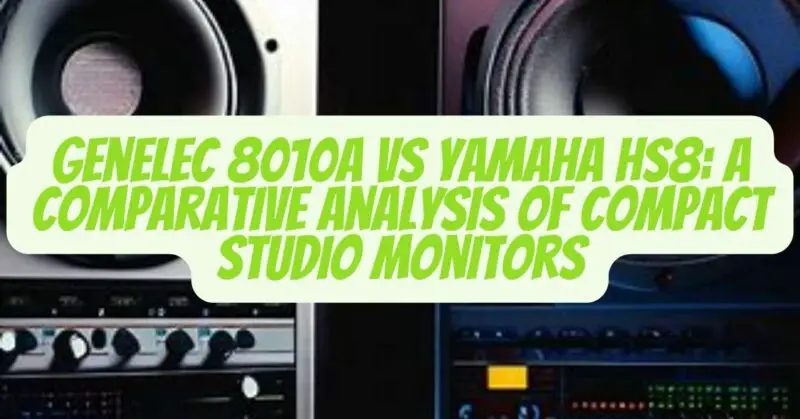When it comes to studio monitors, accuracy and clarity are essential for sound engineers and music producers. The choice of a studio monitor can significantly impact the quality of the audio being produced. In this article, we will compare two popular compact studio monitors, the Genelec 8010A and the Yamaha HS8, to help you make an informed decision based on your specific needs and preferences.
Genelec 8010A
The Genelec 8010A is a compact active two-way studio monitor that packs a punch despite its small size. It features a 3-inch woofer and a 3/4-inch metal dome tweeter, powered by a 25-watt amplifier for each driver. The 8010A boasts an impressive frequency response of 74 Hz to 20 kHz (-6 dB), providing a detailed and accurate sound representation across the frequency spectrum.
One of the standout features of the Genelec 8010A is its exceptional directivity control, thanks to its proprietary Directivity Control Waveguide (DCW) technology. This technology ensures a wide and consistent listening area, allowing for precise monitoring even in acoustically challenging environments. The 8010A also includes room response controls, allowing users to adjust the monitor’s performance to the room’s characteristics.
Yamaha HS8
The Yamaha HS8 is another compact studio monitor that has gained a strong reputation among audio professionals. It features an 8-inch woofer and a 1-inch dome tweeter, powered by a 75-watt amplifier for the low frequency driver and a 45-watt amplifier for the high frequency driver. The HS8 offers an extended frequency response of 38 Hz to 30 kHz (-10 dB), providing a powerful and full-bodied sound.
One of the key features of the Yamaha HS8 is its Room Control and High Trim response controls. These allow users to adjust the monitor’s output to compensate for the room’s acoustic characteristics, making it versatile in various studio environments. The HS8 also incorporates Yamaha’s advanced transducer technology, which contributes to its accurate sound reproduction and low distortion levels.
Size and Portability
In terms of size and portability, the Genelec 8010A takes the lead. Its compact design makes it ideal for small home studios or mobile recording setups. On the other hand, the Yamaha HS8 is larger and more suited for medium to large studios where space is not a constraint.
Sound Quality
Both monitors excel in reproducing accurate and detailed sound, but they differ in their frequency response and power handling. The Genelec 8010A focuses on the mid to high-frequency range, delivering precise and transparent audio reproduction. Meanwhile, the Yamaha HS8 offers a more extended frequency response with its larger drivers, providing a fuller and more pronounced low end.
Directivity and Room Correction
The Genelec 8010A stands out with its DCW technology, ensuring consistent sound dispersion and minimizing room reflections. The ability to adjust the monitor’s response to the room’s characteristics is an added advantage. On the other hand, the Yamaha HS8 offers room control features that allow users to compensate for acoustic anomalies, providing a more accurate listening experience.
Price and Value
In terms of price, the Genelec 8010A tends to be more expensive than the Yamaha HS8. However, the Genelec brand is renowned for its exceptional build quality and long-term reliability, making it a worthwhile investment for professionals seeking uncompromised performance.
Conclusion
Choosing between the Genelec 8010A and the Yamaha HS8 ultimately depends on your specific requirements. If you prioritize portability, accurate mid-to-high-frequency reproduction, and directivity control, the Genelec 8010A is an excellent choice. Its compact size and advanced technology make it ideal for smaller studios or on-the-go recording setups. The directivity control provided by the DCW technology ensures that you can trust the accuracy of your mixes even in challenging acoustic environments.
On the other hand, if you’re looking for a larger studio monitor with extended low-frequency response and versatile room control features, the Yamaha HS8 should be on your radar. Its 8-inch woofer delivers a powerful and full-bodied sound, making it suitable for medium to large studios. The ability to adjust the monitor’s output to compensate for the room’s acoustic characteristics is a valuable feature for achieving an accurate and balanced mix.
In terms of price, the Genelec 8010A tends to be more expensive than the Yamaha HS8. However, it’s important to consider the long-term value and reliability of your investment. Genelec has built a strong reputation for manufacturing high-quality monitors that are built to last. If you are a professional audio engineer or music producer who values uncompromised performance, the Genelec 8010A may be worth the investment.
Ultimately, the decision between the Genelec 8010A and the Yamaha HS8 depends on your specific needs and preferences. Consider factors such as your studio size, portability requirements, desired frequency response, directivity control, and budget. It’s also a good idea to listen to both monitors in person if possible, as subjective listening impressions can play a significant role in making a final decision.
Both the Genelec 8010A and the Yamaha HS8 have proven themselves as reliable and capable studio monitors. Whichever option you choose, either monitor will provide you with the tools you need to achieve accurate and professional sound reproduction in your studio environment. Remember, the most important aspect is to have monitors that you feel comfortable and confident working with, as they play a crucial role in translating your creative vision into a polished and captivating audio experience.


